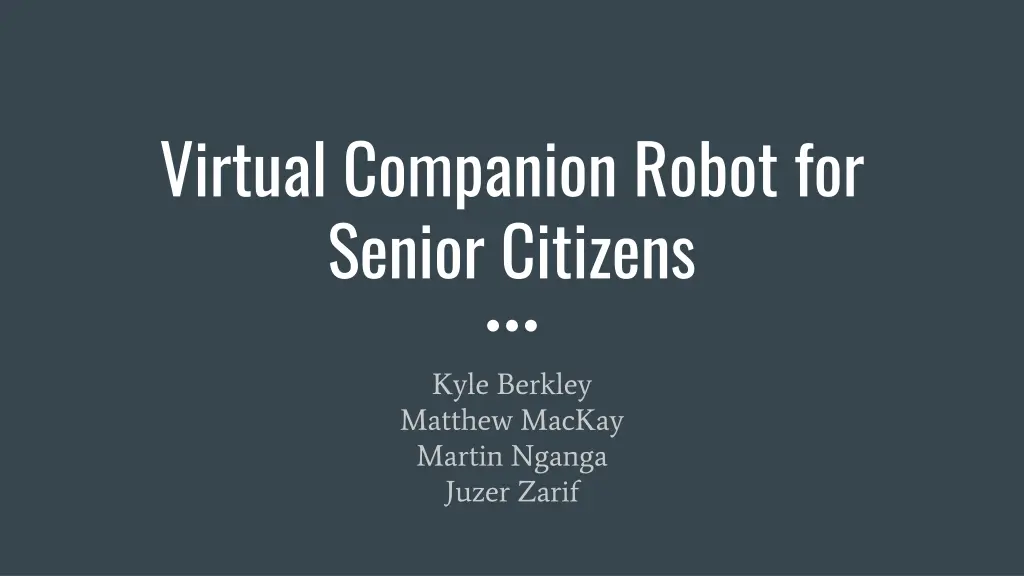
Senior Companion Robot Innovations
Enhance the lives of senior citizens with an empathetic virtual companion robot designed to combat loneliness in eldercare facilities. Discover the motivation, initial design challenges, utilization of JeVois machine vision module, obstacle avoidance strategies, and software development using React Native for mobile applications.
Uploaded on | 4 Views
Download Presentation

Please find below an Image/Link to download the presentation.
The content on the website is provided AS IS for your information and personal use only. It may not be sold, licensed, or shared on other websites without obtaining consent from the author. If you encounter any issues during the download, it is possible that the publisher has removed the file from their server.
You are allowed to download the files provided on this website for personal or commercial use, subject to the condition that they are used lawfully. All files are the property of their respective owners.
The content on the website is provided AS IS for your information and personal use only. It may not be sold, licensed, or shared on other websites without obtaining consent from the author.
E N D
Presentation Transcript
Virtual Companion Robot for Senior Citizens Kyle Berkley Matthew MacKay Martin Nganga Juzer Zarif
Motivations and Use Case Considerable population of senior citizens reside in old age home like facilities High chance of loneliness in these settings (1)(2) Traditional pets require maintenance (3) Empathetic virtual companion serves as possible alternative Could provide additional services as well References: 1. 2. 3. http://thenationshealth.aphapublications.org/content/48/8/E39 https://www.tandfonline.com/doi/full/10.1080/01634372.2018.1478352 https://www.aspca.org/pet-care/dog-care/general-dog-care
Initial Design Attempted to use Raspberry Pi for person detection using haar cascade. Pi s processing couldn t produce an acceptable frame rate with haar cascade analysis (5 to 10 fps) Needed something with more processing power/something with hardware acceleration Possible solutions included higher power x86 machine (expensive). A couple of forum users suggested the JeVois machine vision module
JeVois Machine Vision Module Video sensor + Quad core CPU + USB video output + Serial output Used provided ArUco marker library for reliable and fast detection (output frame rate 15 - 25 frames per second) JeVois sends module output as serial messages containing information about the location of the marker Easy to interface with an Arduino Mega over serial Utilize serial messages from JeVois to control pan-tilt motion using servo motors connected to Arduino Mega. Zero in on pan angles by actuating motors.
Obstacle Avoidance Initially design called for three ultrasonic sensors Initial algorithm only checked for objects in front and looked for best way around Problems: Not enough sensors to cover front of robot Ultrasonic sensors provide inconsistent and unreliable data (i.e. shiny, dark, or non-flat surfaces) Final design uses seven IR sensors in front of robot that provide a shield Final algorithm works like a protective shield . If any object pierces the shield , the robot will either turn out of the way or stop if there is no way out IR sensors overall deal with less data, are more accurate, and have less latency than ultrasonic sensors
Software React Native for mobile application development allowing cross-platform development (create iOS and Android apps simultaneously) Use Expo CLI to enable the use of a simulator for the iOS and Android development process Dynamically generate new Aruco Markers and accept medication information on the mobile app. Display
Future expandability Use native capabilities to communicate send communication over Bluetooth to Raspberry Pi Train the machine vision module to identify and approximate the location of a specific user instead of an ArUco marker Better autonomous collision avoidance (more powerful processor?) Robot could track health data and provide assistance when needed Expand the target demographic for the virtual companion robot by adding smarter empathy response (virtual babysitter) Implement a GUI for the robot or a face to make it more of a companion. https://youtu.be/eFX_fh0F8-0
